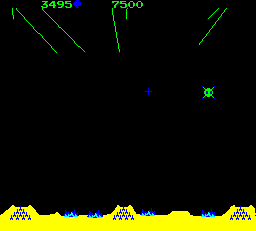Missile Command
type: shooter
genre: Serious game, Defense game, Missile Command-like
setting: Present
perspective: side view
player options: single player
languages: eng
genre: Serious game, Defense game, Missile Command-like
setting: Present
perspective: side view
player options: single player
languages: eng
3.8/5


 Find at ADB
Find at ADBPersonal review
Traditional 1979-81 Atari arcade game, but an impressive challenge thanks to its format of missiles that, once aimed, take time to reach their targets.
 # 2002-12-11 20:26:28
# 2002-12-11 20:26:28
Description
Very few games had proper endings in early videogame history. This one does. It may be first game where losing is intended to be a proper ending.
The six cities are intended to represent Eureka, San Francisco, San Luis Obispo, Santa Barbara, Los Angeles, and San Diego, all in California, USA.
Missile Command II planned for a 1982 release would have been a 2-player cooperative version of the game. It was to have the USA protagonist (player 1) and his USSR counterpart protagonist (player 2) cooperating; each destroying missiles launched by the others' country and ones launched from their own, in order to protect cities on both sides. The "Missile Command II" seen in Arcade Classics is merely a graphics update to the first, not this originally intended cooperative game.
Missile Command was created in a time when Nuclear Holocaust was the biggest fear of most of the population of the USA. Missile Command is propaganda and the message is ominous; tally it however you like but in the end everyone dies. Death by nuclear blast or by fallout, there's just no way to win a nuclear war, so don't start one. It was discussed if there should be an end where the player was told, 'you did it, no more incoming missiles. now lets all proceed with dying from fallout'. While many game of the past had no win conditions due to technical reasons and the youthfulness of the industry, Missile Command's end game conditions were carefully debated, anguished over, and decided. The game’s designer experienced nuclear holocaust every night in his nightmares. There are no game mechanics that are the result of technical limitations or coincidences in Missile Command. The perceived slow travel of the ICBM’s and anti missiles (because of the vast distance they are traveling), is part of the anguish. The perceived slow expansion of nuclear blasts (because of scale) was carefully designed to look like the infamous videos of real nuclear tests. The game mechanic of running out of anti-missiles was not created due to memory constraints or to balance gameplay, it happens so the player can frantically do nothing about it as ICBM’s rain down. It doesn't coincidentally torture the player as many games do can be played into an unwinible state by accident or if the player is off-track; it does so purposefully with an unwinable state at all times and finishes it off with a helpless state. Missile Command does not end with the standard "Game Over", it ends with the very carefully chosen serious statement, "The End". The score is merely imparts a quantified futility in the player and the experience, in some small way, of the insanity of taking any action in a nuclear war (therefore the insanity of starting one to begin with). And it encourage quarters from another individual set on quantifying a higher futility of course. A hollow victory is offered to the next player to beat the current high score; while the world ends, they get to record their initials.
The point of Missile Command really is to lose.
 (Zerothis) - # 2007-05-02 07:56:47
(Zerothis) - # 2007-05-02 07:56:47
The six cities are intended to represent Eureka, San Francisco, San Luis Obispo, Santa Barbara, Los Angeles, and San Diego, all in California, USA.
Missile Command II planned for a 1982 release would have been a 2-player cooperative version of the game. It was to have the USA protagonist (player 1) and his USSR counterpart protagonist (player 2) cooperating; each destroying missiles launched by the others' country and ones launched from their own, in order to protect cities on both sides. The "Missile Command II" seen in Arcade Classics is merely a graphics update to the first, not this originally intended cooperative game.
Missile Command was created in a time when Nuclear Holocaust was the biggest fear of most of the population of the USA. Missile Command is propaganda and the message is ominous; tally it however you like but in the end everyone dies. Death by nuclear blast or by fallout, there's just no way to win a nuclear war, so don't start one. It was discussed if there should be an end where the player was told, 'you did it, no more incoming missiles. now lets all proceed with dying from fallout'. While many game of the past had no win conditions due to technical reasons and the youthfulness of the industry, Missile Command's end game conditions were carefully debated, anguished over, and decided. The game’s designer experienced nuclear holocaust every night in his nightmares. There are no game mechanics that are the result of technical limitations or coincidences in Missile Command. The perceived slow travel of the ICBM’s and anti missiles (because of the vast distance they are traveling), is part of the anguish. The perceived slow expansion of nuclear blasts (because of scale) was carefully designed to look like the infamous videos of real nuclear tests. The game mechanic of running out of anti-missiles was not created due to memory constraints or to balance gameplay, it happens so the player can frantically do nothing about it as ICBM’s rain down. It doesn't coincidentally torture the player as many games do can be played into an unwinible state by accident or if the player is off-track; it does so purposefully with an unwinable state at all times and finishes it off with a helpless state. Missile Command does not end with the standard "Game Over", it ends with the very carefully chosen serious statement, "The End". The score is merely imparts a quantified futility in the player and the experience, in some small way, of the insanity of taking any action in a nuclear war (therefore the insanity of starting one to begin with). And it encourage quarters from another individual set on quantifying a higher futility of course. A hollow victory is offered to the next player to beat the current high score; while the world ends, they get to record their initials.
The point of Missile Command really is to lose.
Technical specs
Authors / Staff
Tags (35)
video game
culture
historical
other
hardware
software
creatures
locations
activities
game genre
Related games
collected in
Arcade Classics (Mega Drive)
Arcade's Greatest Hits: The Atari Collection 1 (SNES)
Super Asteroids & Missile Command (Lynx)
Arcade's Greatest Hits: The Atari Collection 1 (Saturn)
emulated by
Arcade's Greatest Hits: The Atari Collection 1 (PS)
Atari Vault (Linux)
has this clone
Polaris (Tandy Coco)
ported to
Missile Command (Atari 2600)
Missile Command (Atari 5200)
Missile Command (Atari 400/800)
Missile Command (Atari ST)
prequel of
Missile Command 3D (Jaguar)
Missile Command 2 (Atari ST)
Arcade Classics (Arcade)
version of
Missile Command (GB)
Missile Command (iOS)
was remade as
Missile Command (PS)
Missile Command (Windows)
Arcade Classic 1: Asteroids / Missile Command (GB)
Arcade Classics (Mega Drive)
Arcade's Greatest Hits: The Atari Collection 1 (SNES)
Super Asteroids & Missile Command (Lynx)
Arcade's Greatest Hits: The Atari Collection 1 (Saturn)
emulated by
Arcade's Greatest Hits: The Atari Collection 1 (PS)
Atari Vault (Linux)
has this clone
Polaris (Tandy Coco)
ported to
Missile Command (Atari 2600)
Missile Command (Atari 5200)
Missile Command (Atari 400/800)
Missile Command (Atari ST)
prequel of
Missile Command 3D (Jaguar)
Missile Command 2 (Atari ST)
Arcade Classics (Arcade)
version of
Missile Command (GB)
Missile Command (iOS)
was remade as
Missile Command (PS)
Missile Command (Windows)
Arcade Classic 1: Asteroids / Missile Command (GB)
Contributors (5)
AndreaD
teran01
zerothis
Sanguine
uvlbot-1
teran01
zerothis
Sanguine
uvlbot-1
Rate and review
1
LIKE
-
PLAYED
FINISHED
OWN
PLAYING
1
WANT


 Post an anonymous comment / review about this game
Post an anonymous comment / review about this game
